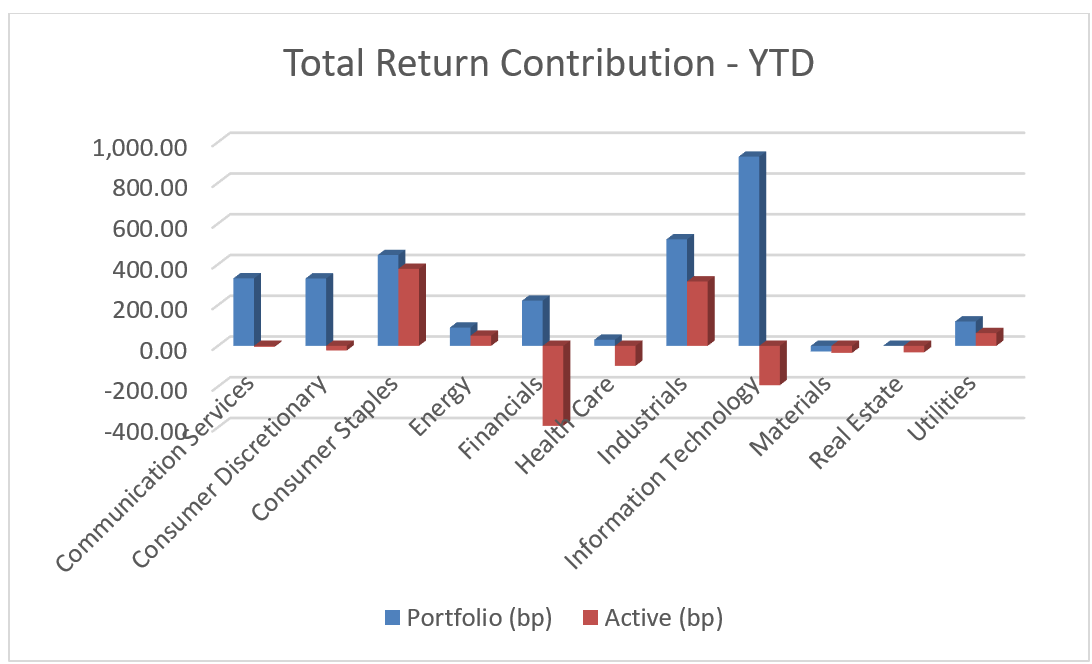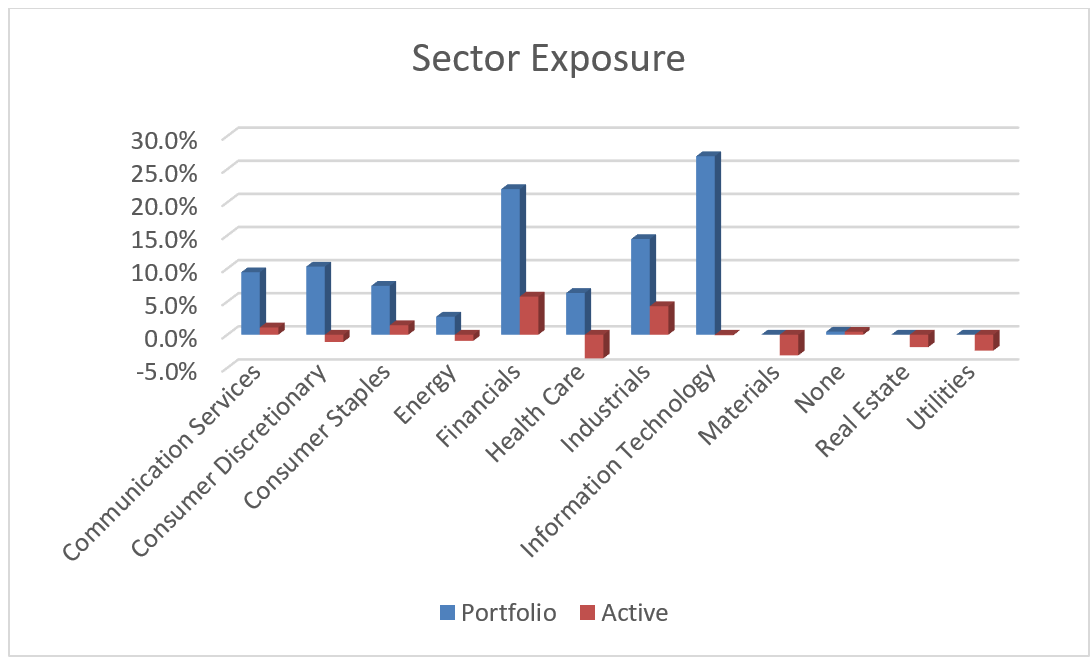Monthly Update
Year-to-date to December 31, the Ninepoint Focused Global Dividend Fund generated a total return of 31.73% compared to the S&P Global 1200 Index, which generated a total return of 29.76%. For the month, the Fund generated a total return of 0.27% while the Index generated a total return of 0.31%.
Ninepoint Focused Global Dividend Fund - Compounded Returns¹ As of December 30, 2024 (Series F NPP964) | Inception Date: November 25, 2015
1M |
YTD |
3M |
6M |
1YR |
3YR |
5YR |
Inception |
|
|---|---|---|---|---|---|---|---|---|
Fund |
0.27% |
31.73% |
10.21% |
13.74% |
31.73% |
11.26% |
12.16% |
9.88% |
S&P Global 1200 TR (CAD) |
0.31% |
29.76% |
5.86% |
11.15% |
29.76% |
11.60% |
13.72% |
12.32% |
It was another excellent year for equities (and most other asset classes), with the S&P 500 posting a +23.3% return (+25.0% on a total return basis), making it two years of +20% returns in a row. The Dow Jones Industrial Average posted a +12.9% return (+15.0% on a total return basis) but, once again, the tech-heavy NASDAQ led the pack and posted a +28.6% return (+29.6% on a total return basis). For Canadian domestic investors, the TSX posted a +18.0% return (+21.7% on a total return basis), which was a relatively decent performance. Broadly speaking, US stocks outperformed international stocks, large caps outperformed small caps and growth outperformed value, consistent with the trends of the past several years. Crude oil was essentially flat for the year, most bond indexes posted positive returns and both gold and bitcoin posted significant gains.
The only minor disappointment of 2024 was the failure of a Santa Claus rally to materialize over the last five trading days of the year. We know that we can’t really complain about much in 2024, but we did observe some weakness through the back half of December that was masked at the index level by strong year end performance of the Magnificent 7 stocks. We would attribute much of the underlying weakness to the US Federal Reserve and the “hawkish cut” on December 18th, when the FOMC cut the target interest rate by 25 basis points to a range of 4.25% to 4.50%. However, the ensuing press conference and the details contained in the Summary of Economic Projections seemed far less dovish than prior meetings, with only two interest rate cuts now forecasted in 2025, down from four cuts. We would point out that market expectations were already there, with the forward curve pricing in only two interest rate cuts in 2025 several months ahead of the final Fed meeting of 2024.
We do wonder if at least some of the hawkish shift was in anticipation of President Trump and his incoming administration’s policies (primarily aggressive fiscal spending and tariffs on foreign-produced goods) that could be largely inflationary. However, we are not convinced that resurgent inflation is lurking around the corner, since some of the President-elect’s policies may prove to be deflationary, and it remains to be seen what will ultimately be enacted. Unfortunately, this change in tone from the Fed was frustrating for many investors, since Chairman Powell had previously taken great pains to highlight his (backward-looking) data dependency.
In any case, the market impact was largely in line with our prior views: if interest rate cuts came in below expectations (implying fewer cuts than expected), large cap growth would outperform but if interest rate cuts came in above expectations (implying more cuts than expected) a rotation from growth to value would occur. As of today, this much anticipated rotation from growth to value has not persisted for longer than a few months at a time but in 2025, as earnings growth rates begin to converge for growth and value stocks, it is possible that we could see better relative performance from value. In the meantime, generally lower interest rates remain supportive for the equity markets as long as the economic data does not deteriorate significantly from here.
Into 2025, we are optimistic for continued positive equity performance and the underlying weakness in December offers a better setup for the year. However, we are mindful that volatility around inauguration day and the potential for portfolio rebalancing during Q1 could create some weakness at the index level. Again, we think that the growth rate differential between the Mag7 and the rest of the market should narrow in 2025, which could support a more lasting rotation from growth to value stocks. Importantly, with S&P 500 consensus earnings estimates rising through 2024, and currently at approximately $280 for 2025 and approximately $305 for 2026 (according to LSEG), we still think equity markets can post solid gains in 2025.
Top contributors to the year-to-date performance of the Ninepoint Focused Global Dividend Fund by sector included Information Technology (+929 bps), Industrials (+523 bps) and Consumer Staples (+446 bps), while only the Materials (-28 bps) sector detracted from performance on an absolute basis.
On a relative basis, positive return contributions from the Consumer Staples (+378 bps), Industrials (+316 bps) and Utilities (+63 bps) sectors were offset by negative contributions from the Financials (-392 bps), Information Technology (-193 bps) and Health Care (-98 bps) sectors.

We are currently overweight the Financials, Industrials and Consumer Staples sectors, while underweight the Health Care, Materials and Utilities sectors. As we approach inauguration day, we will be carefully watching for policy announcements from the incoming President’s administration and the potential impact on growth and inflation expectations. Although we are optimistic about 2025, the key question for the equity markets will be whether President Trump’s policies prove significantly inflationary, thus creating a spike in bond yields. In the meantime, we remain focused on high quality, dividend payers that have demonstrated the ability to consistently generate revenue and earnings growth through the business cycle.

The Ninepoint Focused Global Dividend Fund was concentrated in 30 positions as at December 31, 2024 with the top 10 holdings accounting for approximately 39.7% of the fund. Over the prior fiscal year, 23 out of our 30 holdings have announced a dividend increase, with an average hike of 34.6% (median hike of 6.3%). We will continue to apply a disciplined investment process, balancing various quality and valuation metrics, in an effort to generate solid risk-adjusted returns.
Jeffery Sayer, CFA
Ninepoint Partners

 December 31, 2024
December 31, 2024


